Food plays an important part in Chinese history, culture, and in any Chinese celebrations. The Chinese love to celebrate any festive season by enjoying rich, healthy, and special dishes. One of the most popular foods is Tofu, which is a high-fiber food and a great source of protein. Read on to learn more about what exactly Tofu is, its history, and how to make it.
What is Tofu food?
What is tofu history? Tofu, which is also known as bean curd, is a popular Chinese food which is prepared by curdling soy milk and then pressing the resulting coagulated substance into a solid white block. The block could be super firm, soft, or silken, and there are many varieties of tofu, which we will discuss in this write up. Its origin traces back to the Han dynasty and it has been consumed in China for over 2,000 years.
Generally, tofu has an ingenious taste that is not immediately obvious, so you can use it in both sweet and savory dishes without altering their flavor. Often, it is seasoned or marinated to match different recipes and its spongy texture easily absorbs flavor. In terms of nutritional value, tofu is a good source of plant-based proteins and it is very low in calories. In addition to that, it is very high in iron and has a sufficient amount of magnesium and calcium. It is a great addition to vegan and vegetarian diets, and it is also a great ingredient in meat dishes.
What is Chinese tofu called?
Tofu, also known as “Fu Li” in ancient times, is a traditional and ancient food in China, which is recorded in some ancient books such as “Compendium of Materia Medica” by Li Shizhen of the Ming Dynasty, “Caomu Zi” by Ye Ziqi, and “Wuyuan” by Luo Qi. Tofu has had many different names in different periods and places in China, such as Hanjiang, Ruan Yu, Shui Ban, Gan Zhi, Yan Lao, Shu Ru, etc.
In modern times, tofu has many different names in Chinese, such as Li Qi, Li Qi, Lai Qi, Hanjiang, Ru Zhi, Ruan Yu, Guocai, Xiao Zai Yang, Wang Liang, Shui Ban, Shui Pan, Shui Lin, Gan Zhi, Bai Hu, Bai Ma Rou, Dou Ru, Dou Pu, Yan Lao, Su Ti Hu, Plant Meat, Shu Ru, Zhi Su, etc.
Here are some examples of slang terms for tofu in different regions or industries:
Wang Liang: In the old days, this was a slang term for tofu among shadow puppet performers (as stated in the commentary of the Xi’an Shadow Puppetry Museum).
Shui Huan: This is a slang term for tofu among mushroom farmers in Longquan, Qingyuan, Jingning and other counties in Zhejiang Province.
Shui Pan: This is a slang term for tofu in Chengdu, Sichuan Province. According to the “Chengdu Tonglan” (published by Chengdu “Tongsu Bao” Press) compiled by Fu Chongju at the end of the Qing Dynasty, there are several names for tofu, such as “Shui Ban”, “Shui Pan”, and “Shui Lin”.
Shui Lin: This is a slang term for tofu in the tofu industry in Chengdu, Sichuan Province and Yong’an, Fujian Province in the past.
Bai Wu: Tofu has many names, including in Japan. According to the “Shaxueji” by Kinen Nasuto, tofu is called “Hakuhaku” in Japan, and among women, it is called “Bai Wu”.
Tofu has a long history and is said to have been invented by Liu An, the grandson of Emperor Liu Bang of the Han Dynasty, in 164 BC in Anhui Province, China. Liu An accidentally added gypsum to soy milk while making medicine on Bagong Mountain on the border of Shouxian and Huainan, and thus invented tofu.
Who invented Tofu?
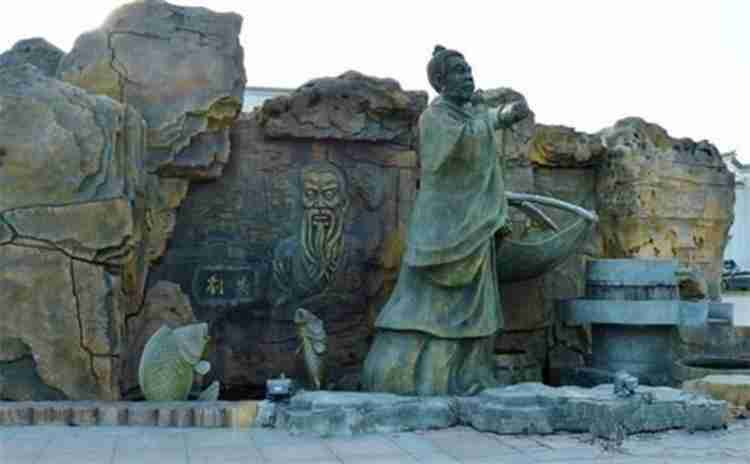
According to Chinese historical records and other literary works, tofu-making originated in the Han Dynasty about 2,000 years ago. Supposedly, tofu was invented by Prince Liu An of Anhui province, who reigned between 179 and 122 BC. It was then introduced to Japan during the Nara period, between 710 and 794 then it got to Vietnam and other parts of Southeast Asia. Supposedly, the spread of tofu-making and production was accelerated by the Buddhist belief that their East Asian Buddhism vegetarian diet needed a great source of protein, and tofu was the perfect fit. Ever since Li Shizen from the Ming dynasty described a tofu-making method, it has become a stable in several countries, including Thailand, Vietnam, and Korea.
There are several legends, fables, myths, and stories that attempt to explain the origin of tofu. One of the most popular theories about who invented tofu claims that tofu was an accidental invention. Supposedly, a cook was in the middle of an experimental cooking period when he flavored soybeans using a type of seaweed known as ‘Nagari’. He ended up with bean curd and it was very delicious. He told everyone about it and popularized tofu-making.
Another common legend about who invented tofu is that it was made by Prince/Lord Liu An of Huai-nan. However, this is greatly contested and most scholars and food critics are convinced that this wasn’t true. The reason behind their argument is that important inventions were always attributed to important leaders of the time, but this wasn’t the case with Prince Liu An and the tofu invention.
Besides those two, another tofu origin story claims that a man discovered tofu when he was trying to feed his parents. According to this story, the man tried all kinds of tricks with cooking soybeans in attempt to make it much easier for his elderly parents to eat. Apparently, his parents had issues with their teeth and could only eat soft food. In the process, he blended soybeans, passed the blend through a cloth, seasoned it, heated it, and when he cooled it down, it became the infamous and greatly loved tofu.
The other theory that attempts to explain the invention of Tofu claims that tofu was crafted based on the cheese-making process. According to this legend, the infamous tofu was created after copying the cheese-making methods of different Mongolian tribes who lived along China’s northern border. These tribes and the East Indians often drank milk, and this was considered a very unusual practice in nearly all Asian countries, but the Chinese were greatly fascinated by the cheese-making process.
Tofu (popularly known as Chinese curd at the time) was introduced to Japan by various Zen Buddhist monks. In America and other parts of the world, Benjamin Franklin is considered the first American to talk about tofu in a letter to John Bartram. He encountered tofu on a trip to London and always identified it as cheese from China.
Ever since it was invented, it has been a great source of protein and a great additive in vegan and vegetarian dishes.
where tofu come from?
Tofu originated in Western Han Dynasty China and has a long history. According to legend, it was invented by Liu An, the grandson of Emperor Liu Bang of Han, in 164 BC. While refining medicine on Mount Bagong on the border of Huainan and Shouxian in Anhui Province, Liu An accidentally curdled soy milk with gypsum, thus creating tofu. According to the “Compendium of Materia Medica”, the method of making tofu originated from Liu An, the Prince of Huainan during the Western Han Dynasty. Liu An, who was the inventor of tofu, was the grandson of Emperor Liu Bang of Han and a contemporary of Emperor Jing of Han, the father of Emperor Wu of Han. The state of Huainan at that time had Shouchun as its capital, which is now Shouxian in Anhui Province. To the north of Shouxian, there is a mountain called Bagong Mountain, which is the birthplace of tofu.
What is Tofu made of?
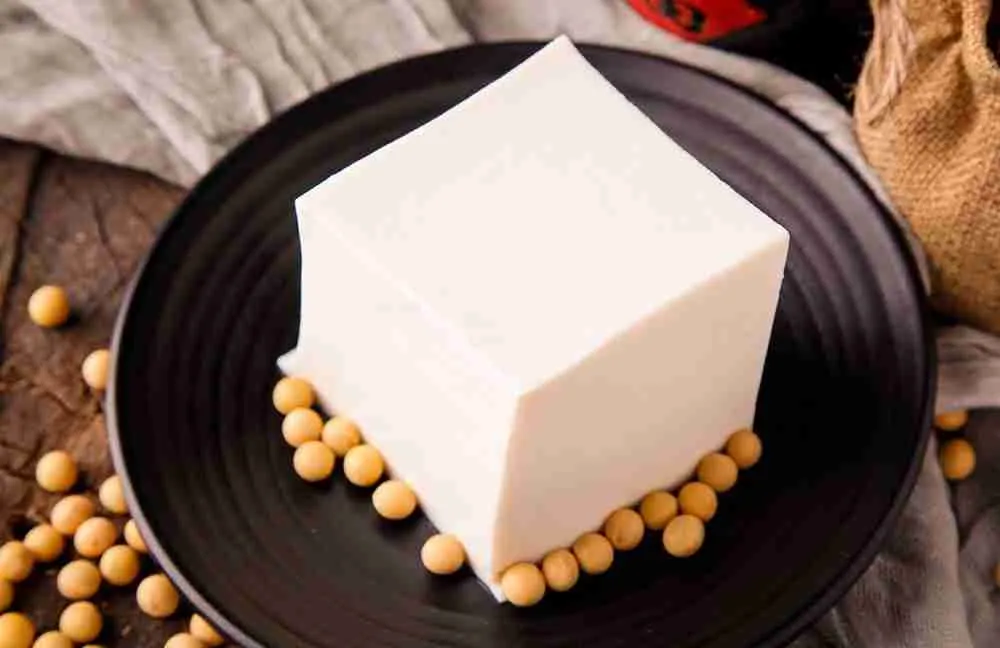
Chinese tofu is made of soybeans that are curdled and pressed into solid blocks, and the process is almost similar to the cheese-making procedure. In addition to that, Chinese tofu contains Nigari, which is the liquid that is left over after salt is carefully extracted from seawater. The Nigari is what you often find the Chinese tofu lounging on once you open its packaging. The Nigari simply gives tofu its spongy texture and iconic shape, and it is very rich in minerals, so you can consider it nutritious. Along with that, tofu is sometimes fortified with vitamins such as B12 and minerals such as calcium or magnesium. This is mostly because it is a great meat substitute for vegans.
The whiteness of Chinese tofu is usually determined by the soybean variety, the degree of aggregation of the tofu gel network, and the soybean protein composition. In addition to that, the yellowish-beigeish color of soybeans is associated with color compounds such as isoflavones, anthocyanin, and polyphenol compounds. That said, the soybean variety that is used actively predicts the color of the final tofu result. To reduce the yellow color of the Chinese tofu, the isoflavone content needs to be reduced so changing the pH of the soy milk solution that was used in the production of the tofu. In the process, any relevant compounds seamlessly precipitate out and these are removed during the extraction of the okara. Also, adding high levels of calcium salts or a higher protein content actively contributes towards forming a much dense and aggregated gel network that disperses more light, and the end result is tofu with a much whiter appearance. In that regard, you can easily find all these ingredients in Chinese tofu.
When it comes to flavor, the tofu flavor is often described as subtle and bland in North America, but the East Asians comfortably describe its flavor as beany. The bland or beany flavor is mostly generated during the grinding and cooking process. In this case, a hot grind or cold grind directly influences the final taste of the tofu. The hot grind method reduces the beany flavor, while the cold grind method produces ester volatile, alcohol, and aldehyde compounds that create beany flavors. That said, you are likely to find these ingredients indicated at the back of the tofu packaging.
Types of Chinese Tofu
There is a wide variety of tofu types and flavors that are available in the Asian markets, Western markers, and other worldwide markets. Despite the wide range of options, Chinese tofu is split into two main categories: processed tofu, which is fully produced from fresh tofu, and fresh tofu which is made directly from soy milk. That said, let us expound on some of the different types of Chinese tofu. They are;
Fresh Tofu
Fresh tofu, which is also known as bean curd, originated in China. It is mostly made from soy milk, a curdling agent, and water. Its production is similar to the cheese-making process, as it is made from curdling soy milk. Thereafter, the resulting curds are slowly pressed into blocks that look like chunks of cheese. It often comes in plastic containers in the produce or refrigerator section of nearly all grocery stores.
In addition to that, fresh tofu is very high in protein and minerals such as calcium and iron. It has very little fat and low calories. It has very little flavor, which can be quite hard to detect and it barely has any smell. Even so, it has the ability to easily absorb new flavors through various spices and marinades that you use for a particular recipe. That said, you can always add fresh tofu to things like blended sauces, purees, smoothies, soups, and any other recipes. Also, you would be impressed by the fact that fresh tofu easily minimizes any added fats and oils that may be used during any common cooking methods. The different types of fresh tofu are;
Soft/Silken Tofu
Soft/Silken Tofu is the typical tofu that is popularly eaten in South China, and it is usually used to make savory soups. Also, it is often a great additive to saucy recipes, such as smoothies and dressings, and you can also use it as a substitute for eggs or yogurt. It is very white in color and it has the highest amount of moisture of all fresh Chinese tofus. Along with that, it is very delicate and heavy, and it easily falls through your fingers under its own water weight. For this reason, you need to handle it as carefully as you would a poached egg.
Besides that, soft/silken tofu is very difficult to pick up using chopsticks, which is why it is often eaten with a spoon. Sometimes it is served at breakfast with the addition of flavorings such as chilli sauce, properly chopped spring onions, soy sauce, or dried shrimp.
Firm Tofu
Firm tofu, which is mostly found in North China, has a yellowish-beige color and it easily regains its shape whenever it is pressed. It is made from denser soy milk, and very little moisture is added during the milk production process. In addition to that, it has the firmness of raw meat and the texture inside the firm tofu is almost similar to that of a firm custard or paneer. Generally, its skin easily retains the pattern of the muslin that was used to drain it and the exterior part is more resistant to any damage than the inside part. That means that you can easily pick up firm tofu using chopsticks.
Aside from that, it you should know that firm tofu is found in areas such as mountain villages, remote islands, and heavy snowfall areas where traveling is inconvenient. Also, it is the most ideal option for stir-frying.
Dried Tofu
Dried tofu is extra firm and it contains the least moisture out of all tofu types. It is great for stews, soups, vegetables, chili, and bean dishes. Also, it is a great additive for dishes that have hiziki and arame sea vegetables. All in all, it is quick to cook and it is a great source of high-quality vegetable protein. In addition to that, it has a very low amount of saturated fat, is sodium free, and is cholesterol free. Often, it is recommended for home use and camping. Also, it looks like loose-cooked noodles and you can choose to serve it cold or stir-fried, depending on your preference
Processed Tofu
Several forms of processed tofu exist. Processing techniques were invented before refrigeration was introduced to preserve tofu or to increase its shelf life. There are two main types of processed tofu, which are;
Pickled Tofu
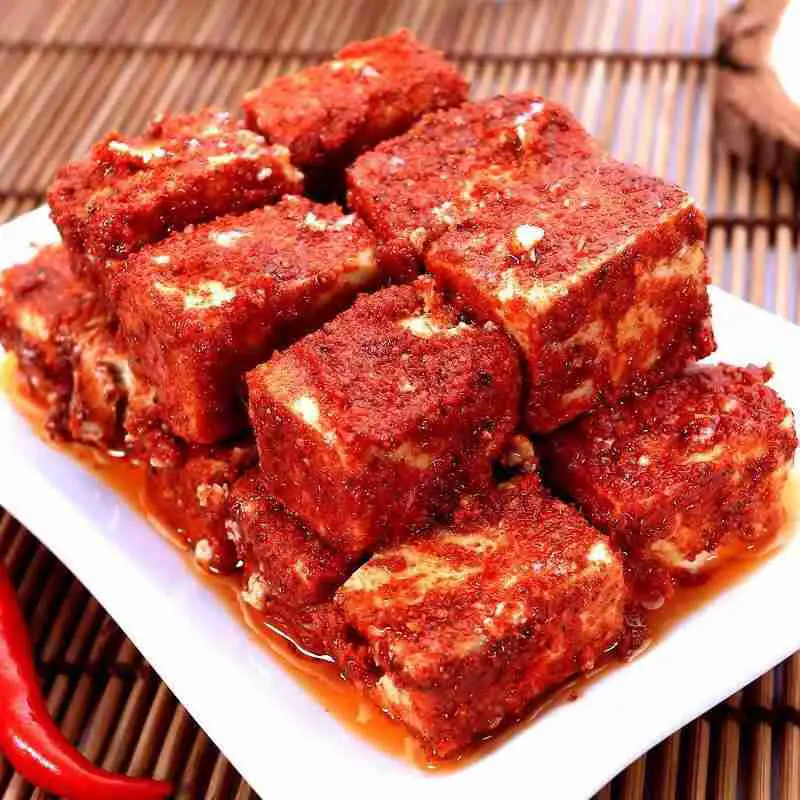
Pickled tofu, which is also known as fermented or preserved tofu, consists of small cubes of dried tofu that have been air-dried under the hay, then allowed to ferment with the help of aerial bacteria. When dry, it is soaked in vinegar, rice wine, salt water, and minced chili for further fermentation.
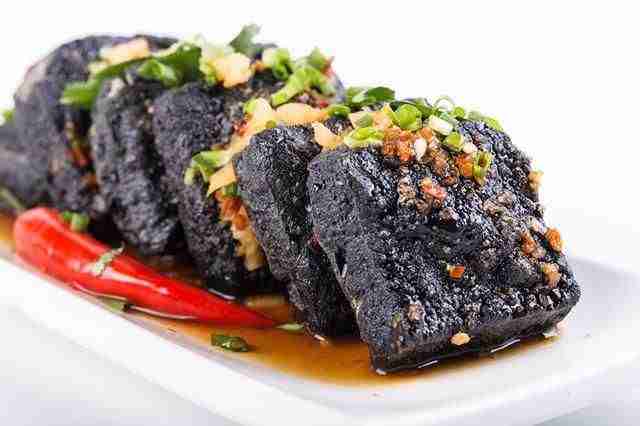
Stinky tofu is a smelly kind of quick snack that has a strong odor that is often described as fecal or rotten. It is fermented in a vegetable and fish brine, which explains its pungent fish smell that sometimes resembles rotten food. It is a delight to aficionados who claim that it is a savory dish and they value its texture. Often, it is served with soy sauce, hot sauce, sweet sauce, or spicy sauce, which often adds to its flavor.
Why do Chinese eat Tofu?
Tofu and soybeans are a great part of Chinese culture. Generally, a woman who is very beautiful but is also poor is said to have bean curd beauty (Tofu Xishi). One of the four great beauties of China, known as Xi Shi is said to have been so beautiful that fish would freeze and sink to the bottom of the river when she washed her veil by the river. For this reason, her name was synonymous with beauty. In a certain novel hometown, Aunt Yang who was a very beautiful shop owner was named ‘Tofu Xishi’. Since then, the name was used to describe ladies with beautiful faces who are needy.
Besides that, another Chinese legend claims that a young couple ran a tofu shop in Chan’an where the husband always took time to make tofu at night, while the wife would keep the shop during the day. His wife was very beautiful, and her beauty made the Chinese believe in the effectiveness of tofu on cosmetic skin care.
In addition to that, tofu is an important dish on the reunion table during the Chinese New Year/Lunar New Year. This is mostly because the word ‘tofu’ sounds like the word that means fortune and happiness in Chinese. Based on this description, the Chinese believe that eating tofu frequently brings good luck to the whole family and everyone sharing in the meal.
what does tofu symbolize
Tofu has different symbolic meanings in different cultures and contexts. Here are a few examples:
In traditional Chinese culture, tofu is associated with longevity and good health. It is often eaten during the Mid-Autumn Festival and the Chinese New Year as a symbol of prosperity and happiness.
In Japanese culture, tofu is considered a symbol of purity, simplicity, and humility. It is also associated with the Buddhist principle of non-violence and is often used as a substitute for meat in vegetarian and vegan dishes.
In Western cultures, tofu is often seen as a symbol of healthy eating and a plant-based lifestyle. It is popular among vegetarians, vegans, and health-conscious individuals for its high protein and low fat content.
Overall, tofu is often viewed as a versatile and nutritious food that can be enjoyed in a variety of ways, and its symbolic meanings reflect the cultural and historical contexts in which it is consumed.
Tofu meaning in Chinese culture
- The symbolism of tofu is auspiciousness and good health. The homophonic sounds of tofu in Chinese include “dufu” and “dufu”, which are associated with the wishes for good fortune and good health in the new year. It expresses the longing for a better life.
- Tofu is white in color, similar to jade, which is also white in color. Therefore, tofu represents the “jade food” in the saying “fine clothes and jade food” (meaning a life of luxury and abundance), symbolizing abundance and prosperity. During the Chinese New Year, every household prepares tofu.
- If tofu is made into tofu balls, it symbolizes that good fortune can roll in like balls. Also, because tofu is white and tender, it also has the meaning of “water lily blooming out of water”.
eating tofu meaning in Chinese
- “Eating tofu” now mostly refers to teasing or taking advantage of someone. It can also mean joking around. In the past, when a family was in mourning, they would prepare tofu dishes for visitors. So, eating tofu at a funeral became a custom, and it’s also known as “eating tofu rice”.
- Some people often shamelessly mooch meals to fill their bellies, and over time, “eating tofu” took on the meaning of taking advantage of someone. When used in the context of men taking advantage of women, “eating tofu” refers to men taking advantage of women.
- In the thirteenth chapter of “Ziye,” it says, “Don’t worry, I behave properly around women, I don’t make advances, I don’t ‘eat tofu’.” Here, “eating tofu” refers to teasing or taking advantage of women.
“Eating tofu” is used to refer to teasing women. It’s said that in the past, the proprietress of a tofu shop had delicate skin and tender flesh due to frequently eating tofu, and she couldn’t help but show off her charm to attract customers. This led to men coming to the tofu shop to flirt with the proprietress under the pretext of eating tofu and even getting handsy. As a result, “eating tofu” became synonymous with men teasing women. Of course, some people believe that in the past, tofu dishes were always prepared for visitors at funerals, which is why eating tofu at a funeral became a custom.
Regardless of which explanation is true, “eating tofu” has come to mean taking advantage of someone in Chinese. Chinese people have always valued etiquette and tend to use language that is more tactful. So, even when criticizing others, they often use words with exten
tofu Chinese new year
The symbolism of eating tofu during Chinese New Year is that it represents good luck rolling in like tofu balls. Eating tofu during the New Year is also a way of praying for a prosperous and happy life in the coming year. The word for “tofu” sounds like “all fortune” in Chinese, which implies that everyone in the family will be blessed with good fortune if they eat tofu together.
The tradition of eating tofu during the Spring Festival originated from the practice of making tofu on the 25th day of the twelfth lunar month in the northern region of China. People hope for a comfortable life with surplus food and clothing every year, which is also known as striving for Xiaokang (moderately well-off). Tofu represents the “jade food” of a comfortable life, and since both tofu and jade are white, they are similar in appearance. Therefore, every family grinds soybeans to make tofu for consumption during the New Year.
The homophone of “tofu” in Chinese is “all fortune”, which implies that everyone is blessed with good health and well-being. Additionally, the homophone of tofu is “all wealthy”, which expresses the hope that everyone will become wealthy in the new year.
tofu in Chinese wedding
In some parts of China, there is a traditional wedding custom where tofu is placed when the daughter is getting married. It symbolizes the sadness of departure and blessings as the bride leaves her parents’ home. During the wedding, the bride’s parents will place a piece of tofu at the door, and the bride must step on it as she walks out, symbolizing that she is embarking on a new journey in life and hoping that her marriage will be smooth and happy.
Eating tofu during weddings is a tradition in specific regions of China because the sound of “doufu” (tofu) is similar to “doufu” (all rich). It symbolizes happiness and prosperity. However, this custom is only practiced by a small portion of the population. Most people believe that tofu is a dish reserved for funerals and should not be served at weddings. Similarly, various types of sprouts are also prohibited from being served at weddings due to the saying, “Even if the sprouts grow to the sky, they are still just a small dish.” Serving sprouts is considered a sign of disrespect towards the bride’s family. Additionally, pork feet and chicken claws are not allowed to be served at weddings because they are believed to symbolize that the newlyweds will have to run away in the future, which is considered a bad omen.
Chinese funeral and tofu
Why is the funeral called tofu rice? When hosting a funeral in China, it is customary to provide food for those who have helped with the arrangements, and the food served is called “tofu rice”. This vegetarian meal usually consists mainly of tofu, without much meat or alcohol. At the end of the funeral, a block of tofu is also served as a thank-you gesture to those who have attended.
Since the tofu feast is intended as a reward for those who have helped with the funeral, it is generally not acceptable to decline the invitation, especially if one has provided financial assistance. In many regions, the wedding banquet is also referred to as tofu rice or tofu soup rice. Thus, eating tofu rice is a funeral tradition that is still observed in many areas.
Originally, this type of feast featured mainly tofu dishes, but over time, the cuisine has become more diverse, and now includes poultry, fish, and other meats as well. However, tofu remains an essential dish, and is typically served as the final course. Once the tofu dish is served, the banquet is considered to be over. Thus, in many places, this dish is also referred to as the “dispersal feast”, as it is the final course.
The fact that tofu is a staple of both funeral and wedding banquets in China illustrates the vast regional differences in customs and traditions across the country.
Tofu in Taoism
Tofu, also known as bean curd, has a special place in Taoist philosophy and cuisine. In Taoism, tofu is considered a pure food that can help achieve balance and harmony in the body and mind.
Tofu is a popular ingredient in vegetarian and vegan diets, which are often associated with Taoist beliefs. The Taoist philosophy emphasizes the importance of living in harmony with nature and the balance of yin and yang energies. Tofu, as a plant-based food, is seen as a way to promote this balance and harmony.
In Taoist cuisine, tofu is often prepared in a simple, unadorned way to showcase its purity and natural flavor. It can be steamed, boiled, or fried, and is often served with vegetables, grains, and other plant-based foods. Tofu is also used as a meat substitute in many dishes, such as mapo tofu and tofu burgers.
In addition to its use in cuisine, tofu has also been used in traditional Chinese medicine as a remedy for various ailments. It is believed to have a cooling effect on the body and can help with digestion, among other benefits.
Overall, tofu plays a significant role in Taoist philosophy and cuisine, reflecting the importance of balance, harmony, and purity in both the body and the natural world.
Tofu and Alchemy
Tofu has a significant association with alchemy in traditional Chinese culture. In alchemy, it was believed that consuming tofu could lead to immortality. Tofu was seen as a pure and wholesome food that could purify and nourish the body and soul. The Taoist alchemists viewed tofu as a food that could harmonize the elements in the body and help to achieve balance and inner harmony.
The history of Chinese people eating tofu can be traced back a long way. In some ancient texts, such as Li Shizhen’s “Compendium of Materia Medica,” Ye Ziqi’s “Grass Catalog,” and Luo Qi’s “Origin of Things,” there are records of the tofu-making method dating back to Han Huanan King Liu An. Legend has it that Liu An, in search of immortality, recruited alchemists at great expense to refine elixirs of life. They ground mountain spring water to make soybean milk and used it to cultivate elixir seedlings. Unexpectedly, the elixir failed to materialize, but the soybean milk mixed with salt brine to form a fragrant, tender, and white substance that was delicious. Brave farmers in the area tasted it and found it to be delicious, so they named it “tofu.”
In the Taoist tradition, there is a belief that the consumption of certain foods can have a transformative effect on the body and mind. Tofu, as a vegetarian food, is considered to be a food that is in harmony with nature and the Tao, and is therefore seen as having a positive effect on the body and soul.
Additionally, tofu was also used as an ingredient in alchemical experiments to create elixirs of immortality. It was believed that the unique properties of tofu could help to transmute base metals into gold and other precious substances.
tofu in Buddhism
Tofu has a significant role in Buddhism, particularly in East Asian Buddhist cuisine. Buddhists practice a vegetarian diet as a way of showing compassion towards all sentient beings, and tofu is an essential protein source in this diet. Additionally, Buddhist monasteries in China, Japan, Korea, and other East Asian countries have long been known for their skill in making tofu.
Some Buddhist teachings also emphasize the importance of simplicity, and tofu’s plain and unassuming nature aligns with this principle. Moreover, some Buddhist monasteries have used tofu as a way of generating income, selling it to support their operations and charity work.
In summary, tofu plays an important role in Buddhist cuisine as a vegetarian protein source, and its simplicity aligns with Buddhist principles of compassion and non-attachment.
Tofu in Confucianism
Tofu, a staple food in many East Asian countries, including China, has been associated with Confucianism for centuries. Confucianism is a philosophical and ethical system that emphasizes the importance of personal and governmental morality, social harmony, and respect for authority.
Furthermore, tofu’s versatility in cooking and its ability to absorb flavors and seasonings have made it a popular ingredient in many vegetarian and vegan dishes, which aligns with Confucianism’s emphasis on compassionate living and ethical consumption.
Overall, tofu’s association with Confucianism reflects the traditional values of simplicity, frugality, and ethical consumption that have been an integral part of East Asian cultures for centuries.
Tofu in Feng Shui
Feng Shui is a traditional Chinese practice that involves arranging one’s surroundings to promote positive energy and harmony. While tofu is not directly related to Feng Shui, it can be considered in the context of the practice’s emphasis on balance and harmony.
From a dietary perspective, tofu is often seen as a healthy and balanced food option that can promote well-being and vitality. In this sense, including tofu in one’s diet can be seen as a way to promote physical health and balance, which can in turn contribute to a more harmonious living environment.
In terms of incorporating tofu into one’s physical environment, it is possible to use tofu as a decorative element in the kitchen or dining area, which can help to promote a sense of balance and harmony in the space. For example, displaying a decorative tofu sculpture or incorporating tofu-inspired artwork into the space can create a sense of balance and promote a connection with the natural world.
Overall, while tofu may not have a direct connection to Feng Shui, it can be considered as part of a holistic approach to creating a harmonious living environment that supports physical health and balance.
tofu in five elements
In traditional Chinese philosophy and medicine, the five elements (also known as the five phases) – wood, fire, earth, metal, and water – are believed to be the fundamental elements that make up the universe and everything within it. While tofu itself is not associated with a specific element, its properties and preparation can be viewed through the lens of the five elements.
From a culinary perspective, tofu is a versatile food that can be prepared in a variety of ways, including frying, boiling, and baking. These preparation methods can be associated with different elements. For example, frying can be associated with the element of fire, boiling with water, and baking with earth.
In terms of its nutritional properties, tofu is high in protein and calcium, making it a nourishing food that can support the health of the bones and muscles. This could be seen as relating to the element of metal, which is associated with strength and resilience.
Additionally, tofu is often used as a meat substitute in vegetarian and vegan diets, which aligns with the element of wood, representing growth, vitality, and renewal. Using tofu as a substitute for meat can be seen as promoting a more sustainable and environmentally conscious way of eating.
Overall, while tofu itself is not directly associated with one of the five elements, its preparation, nutritional properties, and use in various diets can be viewed through the lens of the five elements, providing a holistic understanding of its role in Chinese philosophy and culture.
tofu in yin and yang
In traditional Chinese philosophy, yin and yang are considered opposing yet complementary forces that are present in all aspects of life. Yin represents feminine energy, darkness, coldness, and passivity, while yang represents masculine energy, lightness, warmth, and activity. While tofu itself is not inherently yin or yang, its properties and preparation can be considered in the context of yin and yang.
From a culinary perspective, tofu is a versatile food that can be used in a variety of dishes and preparation methods. For example, it can be used in hot and spicy dishes, which are considered more yang in nature, or in lighter, more delicate dishes, which are considered more yin. Additionally, the temperature at which tofu is served can also be considered in terms of yin and yang, with hot tofu dishes being considered more yang and cold tofu dishes being considered more yin.
In terms of its nutritional properties, tofu is high in protein and low in fat and calories, making it a balanced and nourishing food that can be seen as promoting a balance of yin and yang energies within the body. Its neutral flavor and ability to absorb flavors and seasonings also allow it to be paired with a variety of ingredients, further promoting a balance of yin and yang energies in a meal.
Overall, while tofu itself is not inherently yin or yang, its versatility, nutritional properties, and use in various dishes can be considered in the context of yin and yang, promoting balance and harmony in both the body and the culinary arts.
tofu in Chinese medicine
In traditional Chinese medicine (TCM), tofu is believed to have various health benefits and is considered a nutritious food that can be included in a balanced diet.
From a TCM perspective, tofu is considered a neutral food that is suitable for all body types. It is said to tonify the qi (vital energy) and blood, nourish the yin (feminine energy), and cool the body. As such, tofu is often recommended for people who have a deficiency in these areas, such as those who are experiencing fatigue, weakness, or dehydration.
Tofu is also believed to be a good source of protein, which can help to support muscle and bone health. Additionally, it is low in fat and calories, which can make it a good option for people who are looking to maintain a healthy weight.
In TCM, the way that tofu is prepared can also affect its properties and health benefits. For example, firm tofu is believed to be more tonifying, while soft tofu is said to be more cooling. Additionally, the addition of certain herbs or spices can be used to enhance the health benefits of tofu or address specific health concerns.
Overall, while tofu is not considered a medicinal herb in TCM, it is viewed as a nutritious food that can support overall health and well-being when included in a balanced diet. Its versatility and neutral properties make it a popular ingredient in many TCM-inspired dishes.
The Story of Tofu
eat tofu story of origin
There is a widely circulated story about eating tofu that dates back to the Han Dynasty. It is said that there was a couple who sold tofu on a bustling street during that time.
Although agriculture was the main industry in ancient times, some handicraft industries, especially small-scale ones like this tofu business, also thrived. To increase sales, the wife who was in charge of the tofu business often had to shout and attract customers.
The wife was fair-skinned and beautiful, with skin as delicate and tender as tofu. Many male customers would line up to buy tofu and secretly touch her hand while paying.
Over time, this behavior of men taking advantage of women became known as “eating tofu.” In addition, there is another layer of meaning that tofu is generally white and delicate, much like a woman’s skin.
tofu for shih tzu
The meaning of “tofu for shih tzu” is a mocking term for a woman who sells tofu. Xi Shi, according to legend, was a beauty of the Yue state at the end of the Spring and Autumn period and one of the Four Beauties of ancient China, and later became a term for a beautiful woman. One of the origins of “tofu for shih tzu” is from Yang Er’s wife in Lu Xun’s “The Hometown”. Referring to her as “tofu for shih tzu” seems to praise her youthful beauty and identity as a “tofu seller” on the surface, but it actually has a deeper meaning. In the south of China, the act of teasing, insulting, or molesting someone is often referred to as “eating tofu”.
Yang Er’s wife in “The Hometown” has such characteristics in appearance, status, and personality: she has some looks but is not a stunning beauty, her family is well-off but not extremely rich, her behavior is not admirable but she likes to look down on others. In addition, her family runs a tofu shop, which matches the literal meaning of “tofu for shih tzu”. Therefore, it is quite appropriate for Lu Xun (or Yang Er’s neighbors) to adopt the folk term “tofu for shih tzu” as her nickname.
different types of tofu
There are several types of tofu:
Brine tofu
Brine tofu is made by adding brine as a coagulant during the tofu making process. The calcium and magnesium ions in the brine react with the soy protein to form a solid, resulting in a firmer and rougher texture. However, brine tofu has a higher calcium content and is a good source of calcium.
Gypsum tofu
Gypsum tofu is made by using gypsum as a coagulant to solidify the soy protein. Gypsum contains calcium sulfate, which has low solubility in water. Therefore, gypsum tofu has a higher water content and a softer texture, with a smooth and tender mouthfeel. However, its calcium content is not as high as brine tofu.
Glucono delta-lactone tofu
Glucono delta-lactone tofu is made by using glucono delta-lactone as a coagulant. It has the highest water content of the three types of tofu, but its calcium content comes solely from itself, making it the lowest in calcium. However, it has a softer texture and a finer and smoother mouthfeel than gypsum tofu.
Japanese tofu
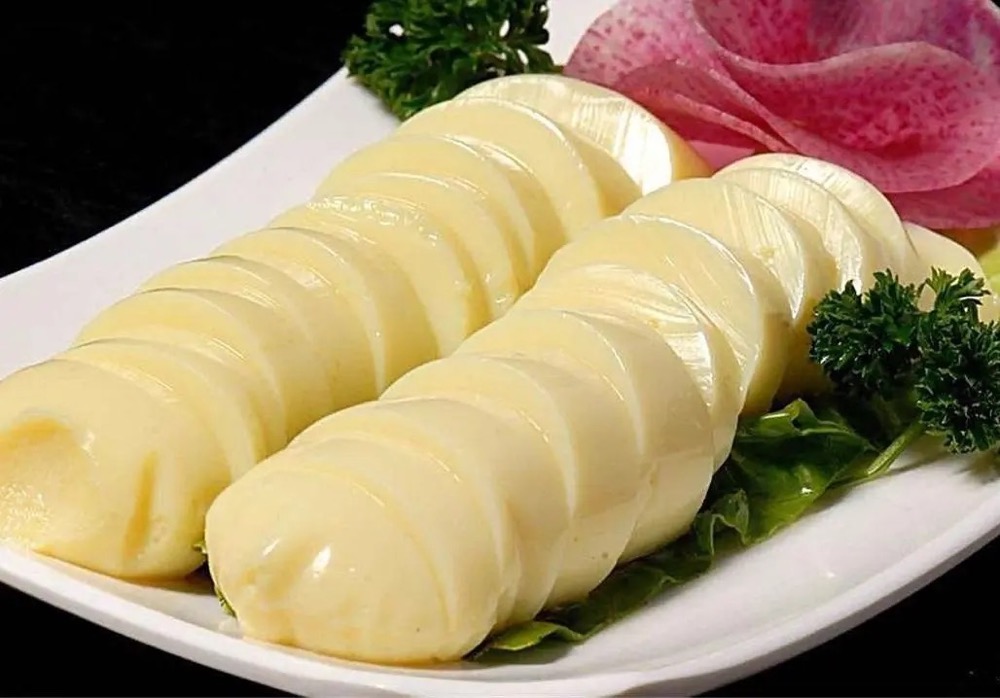
Japanese tofu, also known as egg tofu, is similar in texture to regular tofu. It is mainly made from eggs, supplemented with pure water, plant protein, natural seasonings, and other ingredients, refined through scientific formula. It has a refreshing and tender texture, with the delicious fragrance of eggs. It is highly praised among consumers for its high quality, delicious taste, nutrition, health benefits, convenience, and value for money. It can also be produced in various flavors, such as spicy, sour, and sweet, by choosing different seasonings.
Green Bean Curd
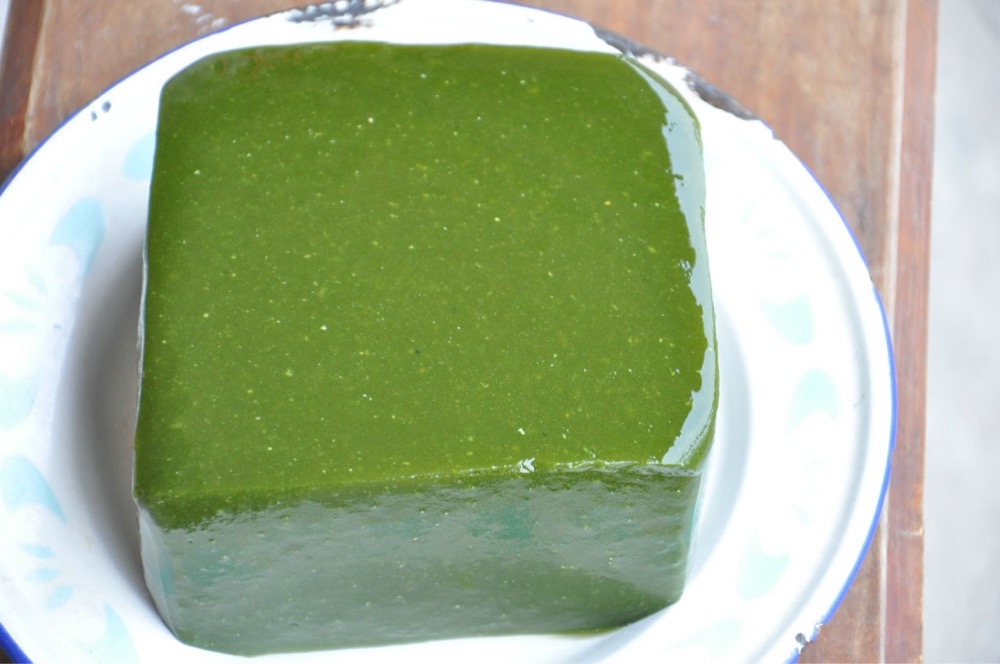
This is a traditional delicacy commonly found in the Wenzhou and Lishui regions of Zhejiang Province. It is made from a wild shrub and is known as “firewood curd” in the Wenzhou area. Although it is not found everywhere in the mountains of southern Zhejiang, it is quite common. Green bean curd is a refreshing and natural green food that helps to cool down during hot summers.
Konjac Bean Curd
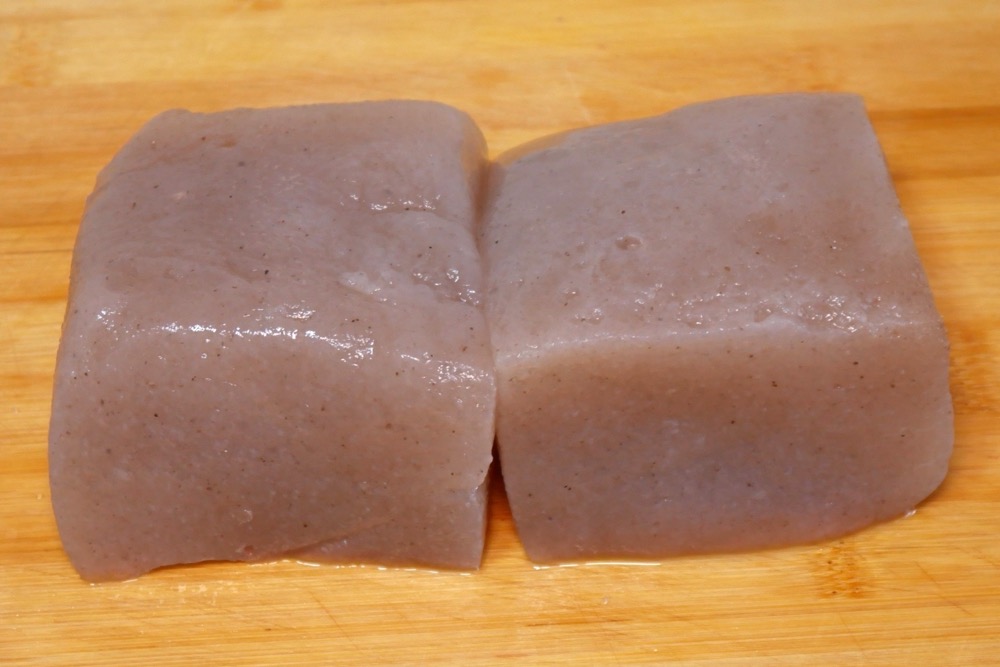
This is a type of Sichuan cuisine that is refreshing and contains abundant soluble dietary fiber. Konjac bean curd is a new type of health food that can be eaten alone or paired with other dishes.
Hairy Bean Curd

This is a traditional dish from the Huizhou region, which features a layer of white hair-like fibers on the surface of the tofu, produced by artificial fermentation. The fermentation process converts the plant protein inside the tofu into various amino acids, giving the dish a particularly delicious taste. Hairy bean curd is a main ingredient in Huizhou and Sichuan cuisine. Its history dates back to the Yuan Dynasty in 1357, when after conquering Bancheng, Zhu Yuanzhang marched north and arrived at Jixi, where he stationed his troops at Kuaihuolin in the south of the city (now Jixi Railway Station). The locals often used water tofu to reward the soldiers. As they received too much water tofu, they could not eat it all at once. As it was hot, the tofu grew white and brown hairs. To avoid wasting the food, Zhu Yuanzhang ordered his cooks to fry and stew it with various seasonings, creating the unique taste of hairy bean curd.
Yellow Bean Curd
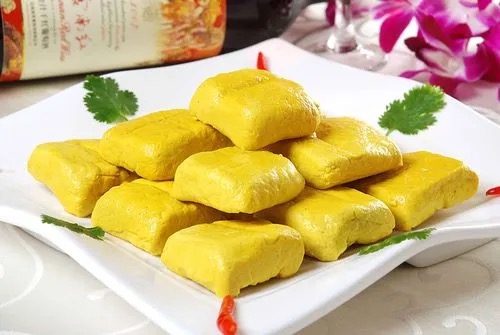
This is another type of tofu, which is made from yellow soybeans and has a criss-cross pattern when the curds are threaded onto a hemp string. It is yellow in color, unlike the more common white tofu, and is shaped like a pair of rectangles. It is fragrant, tender, and flavorful.
Rainbow Bean Curd
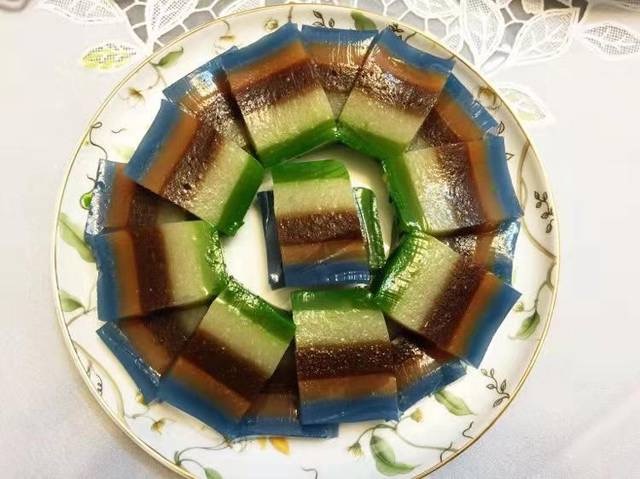
Similar to regular tofu, this bean curd is made from soybeans. However, it is unique in that vegetable and fruit juice is added to give it a rainbow of colors. This type of tofu is rich in nutrients and the dietary fiber from the vegetables helps with digestion and absorption. Rainbow bean curd, like traditional tofu, is made from soybeans, but it also contains natural vegetable and fruit juice to create its vibrant colors. It is rich in nutrients and fiber, which are beneficial for digestion and absorption in the human body.
rice Tofu
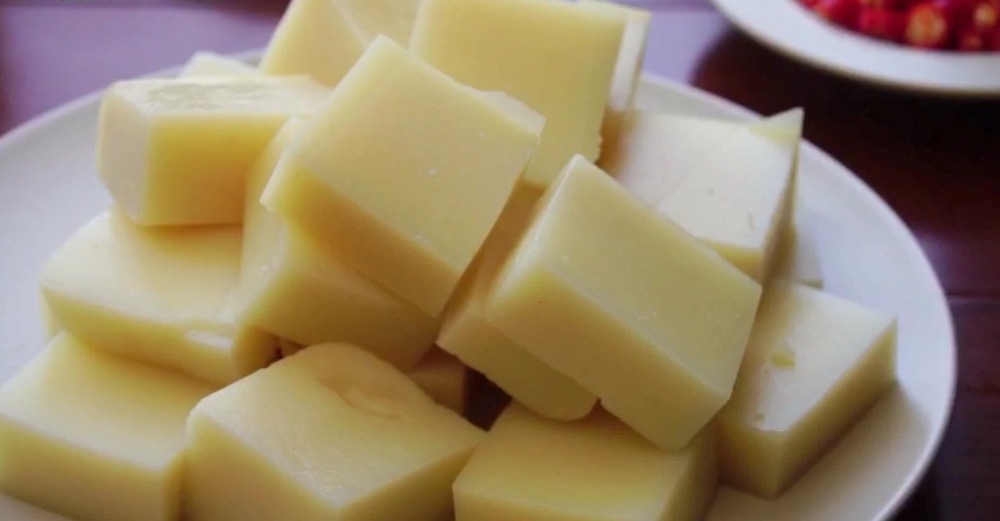
Mifan Tofu is mainly made by grinding rice into a slurry, adding alkali, and cooking while constantly stirring. It is a popular breakfast and dinner option in many rural households. The process involves washing and soaking rice, grinding it into a slurry, adding alkali, cooking, and cooling to form a block of “tofu”. To prepare, the tofu is cut into small pieces and soaked in cold water, then garnished with different seasonings such as chopped pickled vegetables, salted vegetables, crispy soybeans, roasted peanuts, scallions, and soy sauce. Mifan Tofu is a local snack in the Sichuan, Chongqing, Hunan, and Guizhou Wuling Mountain regions.
Fish tofu
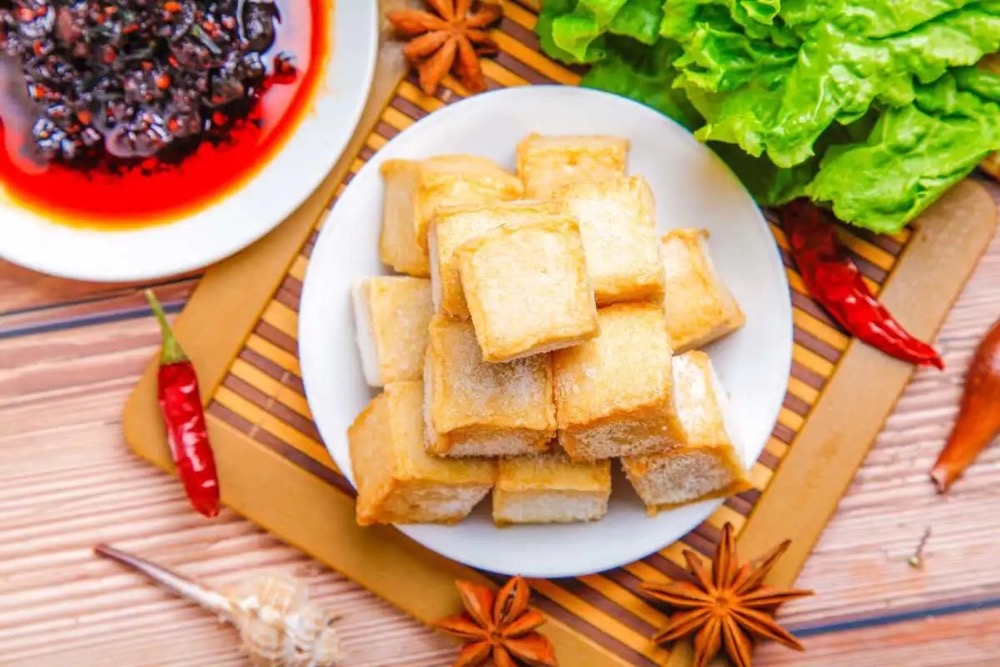
Fish tofu, also known as fried fish cake, is made by grinding fish meat into a paste, mixing it with other ingredients, and pressing it into blocks which are then deep-fried until golden brown. It is popularly served as a side dish for hot pot or spicy hot pot. The dish features a fragrant aroma, a resilient texture, and is rich in nutrients. The main ingredients include fish paste, egg whites, tapioca starch, cornstarch, soy protein isolate emulsion, golden treasure, super-butter flavor, meat essence powder, monosodium glutamate, sugar, refined salt, water, soy protein isolate, lard, ice water, and sodium caseinate.
Guanyin Tofu
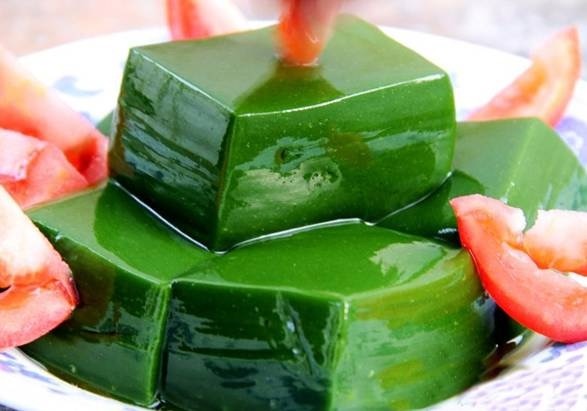
Guanyin Tofu is a type of snack made from leaves of the Fubu tree. It has a jelly-like texture and is refreshing, making it a perfect food for summer. Also known as Shenxian Tofu, this specialty snack is popular in Anhui and Zhejiang provinces in China. The dish is made using the leaves of the Fubu tree, a wild shrub that grows in the Jiuhua Mountain, Anqing, Qushou Lingjiu Mountain, Ruolao Mountain and Dabieshan areas. Due to its seasonal availability and limited quantity, Guanyin Tofu is considered a precious delicacy that is rich in nutrients. The required ingredients include Fubu leaves, and ashes from plants. Other names for Fubu include Stinky Leaf Tofu, Tofu Wood, Divine Ax, Earth Ginseng, Stinky Girl, Cold Powder Leaves, Iron Ring Powder, June Frozen, Stinky Yellow Thorn, Guanyin Wood, Flea Mite Wood, Stinky Tea, Small Green Tree, Sticky Rice Paste, Kneading Paste, Mozi Ren, Tofu Wood, and Mountain Sticky Rice Cake.
Mongolian Milk Tofu
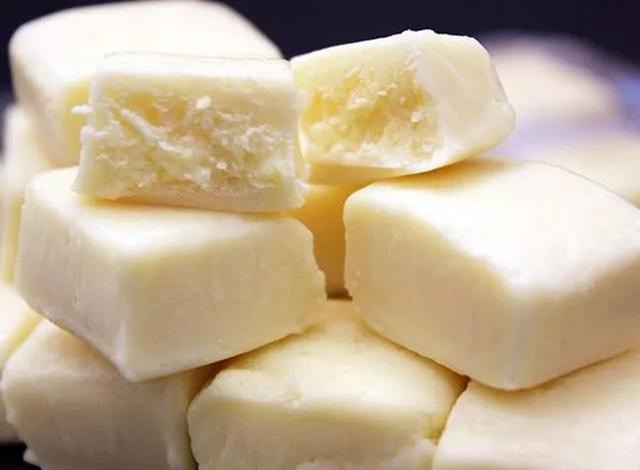
Mongolian Milk Tofu, although it looks and is shaped like white tofu, is actually a dairy product with a strong milk fragrance. Milk tofu, called “Hooroo Da” in Mongolian, is a common dairy food in Mongolian pastoral families. It is made by solidifying and fermenting milk from cows, sheep, horses, etc., and has a shape similar to ordinary tofu, but it is not tofu and is named for its resemblance to tofu. The taste can be slightly sour or slightly sweet, with a strong milk fragrance that pastoralists love. It is often soaked in milk tea for consumption, or taken as a snack on long journeys to quench thirst and satiate hunger. It can also be made into a popular dish called “pulled milk tofu,” which has a soft and stretchy texture and is a flavorful dish at banquets. The taste of milk tofu varies depending on its shape, with thick milk tofu being soft and strongly fragrant, while thin milk tofu is oily, melts in the mouth, and is especially sweet and fragrant.
Abura-age tofu
Abura-age tofu, also known as inari tofu, is a type of Japanese tofu made from soybeans. It is made by deep-frying thin slices of tofu until they are puffy and golden brown. The fried tofu slices are then used as a filling for sushi or as a stand-alone ingredient in dishes like kitsune udon.
Almond tofu
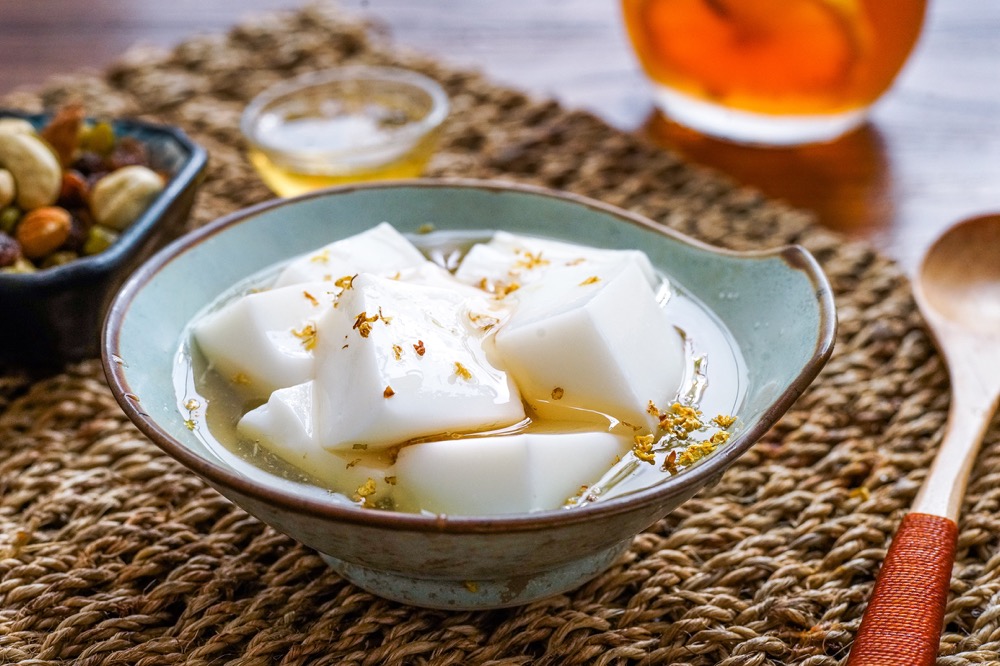
Almond tofu is a traditional dessert from Jiangsu Province, China, and is a specialty in Manchu Han Banquet. It is made by boiling sweet almond milk and then cooling and setting it with a coagulant. The dessert is then cut into small cubes that resemble tofu, and served with fruit or syrup.
Famous Tofu Dish
sauteed tofu in hot and spicy sauce – Mapo tofu
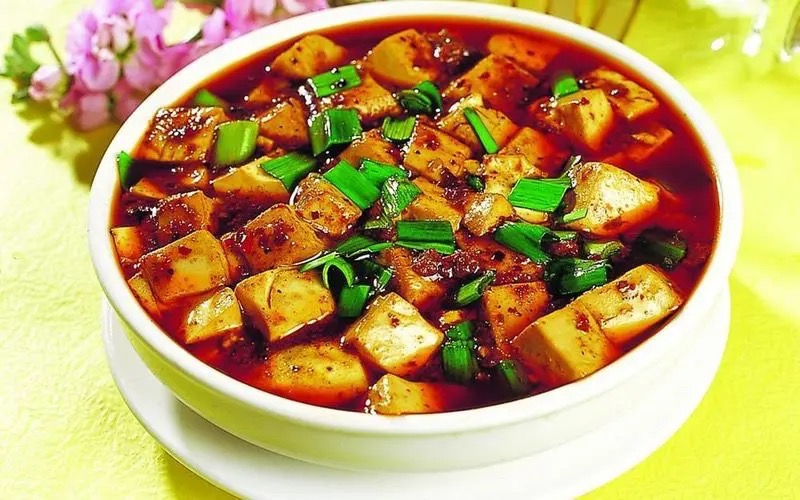
Mapo tofu is one of the traditional famous dishes in Sichuan Province and belongs to Sichuan cuisine. The main ingredient is tofu, and the auxiliary ingredients are garlic sprouts and minced beef (other meats can also be used). The seasonings include douban sauce, chili powder, Sichuan peppercorn powder, soy sauce, light soy sauce, dark soy sauce, sugar, starch, etc. The numbing sensation comes from Sichuan peppercorn, and the spiciness comes from chili powder. This dish is spicy, fresh, fragrant, hot, crispy, tender, and crispy, showcasing the characteristics of Sichuan cuisine’s spicy and numbing flavor. Nowadays, Mapo tofu has spread to the United States, Canada, the United Kingdom, France, Vietnam, Singapore, Malaysia, Japan, Australia, and other countries, and has become an internationally renowned dish after its transformation from a simple home-cooked dish to an elegant delicacy.
Century Egg and Tofu
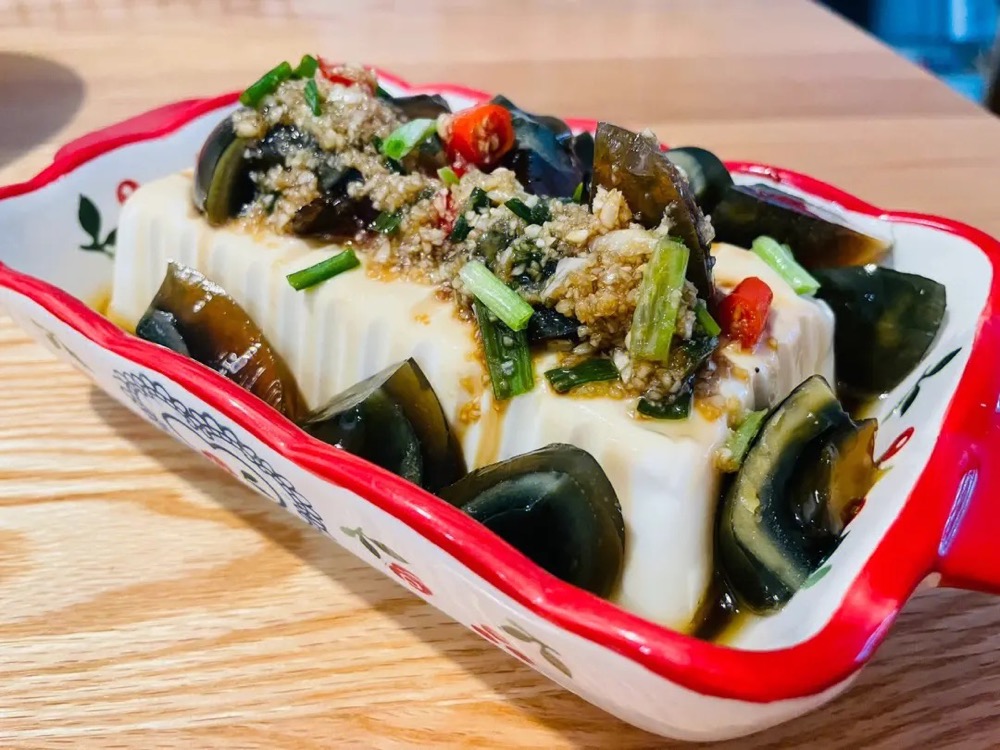
Century Egg and Tofu Salad is a common cold dish made with preserved tofu, pickled mustard greens, century egg, sesame oil, and cilantro. It is easy to make, nutritionally rich, and believed to have cooling properties that can help alleviate internal heat and replenish the body with various essential nutrients.
Legend has it that during the Three Kingdoms period, after Liu Bei borrowed troops from Sun Quan to attack Yi Province, he left Guan Yu to guard Jingzhou. One summer day, the weather was scorching hot, and soldiers were practicing martial arts under the sun, sweating profusely. Over time, many soldiers developed internal heat, suffered from constipation, dark urine, dry mouth, and cracked tongue. Guan Yu was very worried. One day, he was pondering alone in his study when the servants brought him a meal, including a dish of boiled soybeans. Guan Yu immediately thought of tofu, which is said to have a cooling effect in traditional Chinese medicine and can dispel internal heat. He ordered his soldiers to soak the soybeans, make them into a slurry, and added gypsum to coagulate the tofu. However, he added too little gypsum, resulting in a tender tofu that cannot be stir-fried. The soldiers could only eat it with salt. As fate would have it, this kind of tofu was like a good medicine, and soldiers who ate it gradually recovered from their illnesses. Later, some soldiers from Jiangling mixed local century eggs into the tender tofu, along with seasonings, creating a delicious dish that not only tastes great but also has cooling and detoxifying properties. However, Chinese century eggs did not appear until the Ming Dynasty, more than 1,000 years after the Three Kingdoms period, and this legend is not based on historical facts.
Eight-Treasure Tofu

Eight-Treasure Tofu is a famous dish in Hangzhou, Zhejiang Province, belonging to the Zhejiang cuisine. It is not only a delicious dish but also beneficial for post-illness recovery, weight loss, and delicate skin. The tofu is white, tender, and smooth, and the eight treasures add a fragrant aroma, making it both delicious and refreshing. After the founding of the People’s Republic of China, famous chefs in Hangzhou researched and imitated Eight-Treasure Tofu based on ancient Chinese medicine books, developing it into a unique and characteristic Hangzhou dish.
Eight-Treasure Tofu was originally a palace dish in the Kangxi period of the Qing Dynasty. It is said that Kangxi Emperor had a preference for soft and delicious dishes. The imperial chefs often used boneless chicken, duck, fish, and meat to make dishes to satisfy his requirements. One time, the royal kitchen used high-quality soybeans to make tender tofu, added minced meat, ham, shiitake mushrooms, mushrooms, pine nuts, and chicken broth to cook it into a soup. After Kangxi tasted it, he felt that the tofu was extremely tender and the taste was delicious, and he was very satisfied. He believed that this dish had two major characteristics: one is that it used long-lived ingredients such as tofu, shiitake mushrooms, and pine nuts, which can extend one’s life; the other is that the tofu was cooked perfectly, and its delicate and delicious taste surpassed that of bird’s nest. Therefore, the dish was made with eight high-quality ingredients and named “Eight-Treasure Tofu.” It was listed as his most beloved palace dish and treasure dish. Famous literati in the palace were also requested to write down the ingredients and cooking methods of “Eight-Treasure Tofu” as a royal recipe. It was often given as a gift to favored officials, such as Jiangsu Governor Song Zhong. Later, Kangxi also gave the recipe for “Eight-Treasure Tofu” to the Secretary Xu Gan (with the pen name Jianan). When Xu received the recipe, he gave the royal kitchen a thousand taels of silver. Soon after, Xu passed the recipe to his disciple Lou Cun, who then passed it down to his descendants. During the Qianlong period, the recipe had been passed down to Wang Ting, the nephew of Lou’s family, and thus he was called “Wang Ting, the Eight-Treasure Tofu.” It then spread to Beijing and Zhejiang and became famous far and wide. In the Qing dynasty, the great literatus Yuan Mei recorded in “Suiyuan Shidan” that “Wang Ting’s Eight-Treasure Tofu, made by cutting the tender tofu into small pieces, adding fragrant minced meat, mushroom crumbs, pine nuts crumbs, melon seeds crumbs, chicken crumbs, and ham crumbs, and stir-frying them in chicken broth until boiling. It can also be made with tofu brain. It is eaten with a ladle instead of chopsticks. Governor Yu said, ‘This is the recipe that the emperor gave to Secretary Xu Jianan. When Secretary Xu obtained the recipe, the royal kitchen charged him one thousand taels of silver. Governor Wang’s ancestor Lou Cun was Secretary Xu’s disciple, so he got the recipe.’ Eight-Treasure Tofu has been passed down to this day, and it is still widely made in Jiangsu and Zhejiang regions.”
Fried tofu
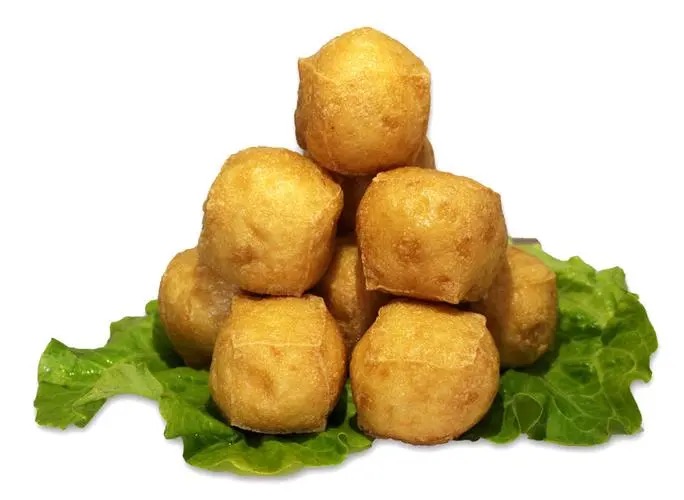
Fried tofu is a traditional and distinctive dish, most famously from Luoding City in Guangdong, China. It is called “doufu pao” in the north and “you doufu” in the south, and some locals in Guangdong refer to it as “dou zha”. As a fried tofu product, it has a golden color, silky texture, fine and airy interior, and is highly elastic. It is made through multiple processes including grinding, molding, and deep-frying.
Wensi tofu
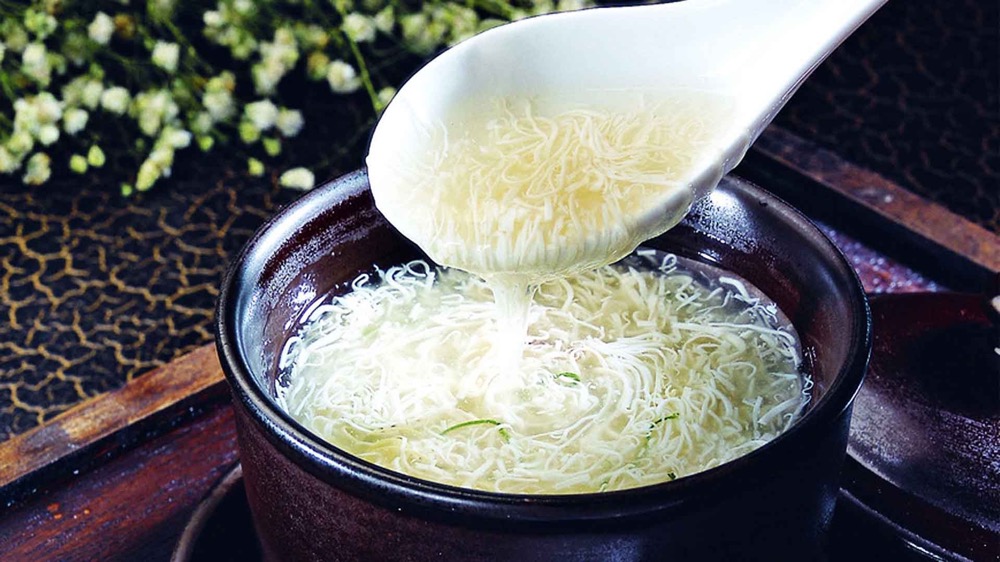
Wensi tofu originated in Yangzhou, Jiangsu Province and is a traditional specialty dish of Jiangsu cuisine, specifically Huaiyang cuisine. This dish has a long history and is made with carefully selected ingredients and finely sliced meat. The texture is soft, tender, and flavorful, and it melts in your mouth. In addition to its delicious taste, this dish is also believed to have the effects of nourishing and strengthening the body, making it a popular choice among the elderly and children. According to the book “Chaxiang Shicong Chao,” written by the Qing dynasty scholar Yu Yue, “Wensi tofu” was named after the poet Xi Fu, who was skilled in making sweet tofu soup and rice porridge. Another name for this dish in “Diaoding Ji” is “Assorted Tofu Soup.”
when tofu comes to japan?
Tofu is believed to have been introduced to Japan from China during the Nara period (710-794) by Buddhist monks. It became an important part of Japanese cuisine and has been consumed in various forms, such as silken tofu, firm tofu, and fried tofu.
During the 10th year of the Tianbao era (757 AD) in the Tang Dynasty, the monk Jianzhen traveled to Japan and introduced tofu-making technology, which made him revered as the ancestor of tofu-making in Japan.
During the Edo period (1603-1868), tofu became more widely available and affordable for common people. It was also during this time that different regions in Japan developed their own unique styles of tofu, such as Kyoto-style yuba (tofu skin) and Nagoya-style miso-katsu (fried tofu with miso sauce).
Today, tofu remains a popular and versatile ingredient in Japanese cuisine, used in dishes such as miso soup, agedashi tofu, and hiyayakko (chilled tofu).
When tofu comes to Korea?
Tofu, also known as bean curd, was introduced to Korea during the Goryeo Dynasty (918-1392) from China. At that time, tofu was a luxury food enjoyed only by the royal court and aristocrats. However, over time, tofu became more widely available and popularized among the general population, and it has since become a staple in Korean cuisine. Today, there are many different types of tofu dishes in Korean cuisine, including sundubu jjigae (soft tofu stew) and dubu kimchi (tofu with stir-fried kimchi).
when was tofu come to europe?
Tofu was introduced to Europe in the early 1900s, primarily through the efforts of health food advocates who were interested in vegetarianism and alternative forms of protein. The first recorded mention of tofu in Europe dates back to 1770, when a French Jesuit missionary named Joseph-Marie Amiot described the production and consumption of tofu in China. However, it was not until the 20th century that tofu became more widely available in Europe. Today, tofu is a common ingredient in vegetarian and vegan cuisine in many European countries.
when was tofu introduced to America?
Tofu was introduced to America in the mid-20th century, during the rise of interest in healthy and vegetarian diets. The specific timeline of its introduction is unclear, but it is believed to have been brought over by Japanese immigrants in the early 1900s and gained popularity among health food enthusiasts in the 1960s and 1970s. Today, tofu is widely available in supermarkets and used in a variety of cuisines throughout the United States.
what cannot be eaten with tofu?
Foods that cannot be eaten with tofu are mainly those with high oxalic acid content, such as spinach, bamboo shoots, amaranth, and water chestnuts, as well as honey.
Tofu should not be eaten with foods high in oxalic acid.
Foods with high oxalic acid content, such as spinach, bamboo shoots, amaranth, and water chestnuts, should not be eaten with tofu. The reason is that tofu is high in calcium, and calcium can react with oxalic acid to form insoluble or poorly soluble calcium oxalate, which affects calcium absorption. Calculi in the human body are formed by the deposition of insoluble calcium salts such as calcium oxalate and calcium carbonate. Therefore, it is best not to eat spinach and other oxalic acid-rich foods with tofu. However, if the cooking method is changed, it is still possible. For example, if spinach, bamboo shoots, and other foods with high oxalic acid content are boiled in hot water first, most of the oxalic acid can be removed, reducing its impact.
Another point worth mentioning is that it is not scientific to eat tofu with scallions because scallions also contain a lot of oxalic acid, which can combine with the calcium in tofu to form white precipitated calcium oxalate, making calcium difficult to absorb. We know that calcium is an essential element for the human body. Long-term consumption in this way may reduce the nutritional value of tofu. If the intake of calcium-rich foods is insufficient, it may lead to symptoms such as irritability, convulsions, and osteomalacia. Therefore, when cooking soy products, it is best to use less or no scallions.
Tofu should not be eaten with honey.
Eating tofu with honey can easily lead to diarrhea.
what goes best with tofu?
Tofu + Egg: Nourishing and Calcium-Rich
With the increasing academic pressure, irregular work schedules, and the demands of taking care of grandchildren for the elderly, many people may experience symptoms of Qi and blood deficiency, such as poor appetite, indigestion, yellowish complexion, cold hands and feet, accelerated aging, and weak immunity.
Tofu has similar nutritional value to milk and is the best substitute for people who cannot drink milk due to lactose intolerance or who do not eat meat and poultry to control chronic diseases. Eggs are also a nutritious food for nourishing blood and Qi according to traditional Chinese medicine.
Tofu + Kelp: Best Diet Therapy for Hypertension, Hyperlipidemia, and Hyperglycemia
Kelp and tofu soup is known as a “miraculous medicine for longevity” and is a healthy and warming breakfast.
The combination of mannitol, iodine, potassium, niacin, and other substances in kelp can effectively prevent and treat arteriosclerosis, lower blood pressure, and its rich dietary fiber is also effective in delaying the rise of blood sugar.
Tofu contains no cholesterol and is very suitable for people with hypertension, hyperlipidemia, and hyperglycemia. Adding tofu dishes to your table is the best way to lower blood pressure and blood lipids.
Regularly consuming tofu and kelp soup can effectively control blood pressure, blood sugar, and blood lipids. Middle-aged and elderly people with hypertension, hyperlipidemia, and hyperglycemia can give it a try.
Tofu + Duck Blood: Nourishing Blood and Protecting the Liver
Animal blood also contains a variety of inorganic salts and trace elements, such as sodium, potassium, phosphorus, iron, zinc, manganese, copper, cobalt, etc. These elements are indispensable to the human body.
Tofu is rich in protein, and tofu protein is a complete protein that not only contains the eight essential amino acids for the human body but also has a proportion that is close to the human body’s needs, making it highly nutritious.
Duck blood and tofu soup can provide both plant and animal protein, and the protein types are very balanced, and it can also supplement iron. In addition, tofu is beneficial for post-illness recovery and skin texture.
Tofu + Chinese Cabbage: Promoting Digestion and Preventing Constipation
In addition to being rich in nutrients, Chinese cabbage also contains vitamin C, β-carotene, calcium, zinc, and other substances, which complement the nutritional value of tofu.
Chinese cabbage is also rich in dietary fiber. When combined with tofu, it can promote digestion and help prevent constipation.
Tofu + Fish: Double Absorption
Fish protein has a suitable amino acid composition for the human body, and its high content of methionine can compensate for the deficiency of methionine in tofu.
Tofu has a high calcium content, and fish is rich in vitamin D. Eating them together can greatly improve calcium absorption rates by taking advantage of the role of vitamin D in the fish body.
Tofu vs cheese
Tofu and cheese are both popular sources of protein and can be used in a variety of dishes. However, there are some key differences between the two.
Tofu is made from soybeans and is a staple in many Asian cuisines. It has a subtle flavor and a soft, spongy texture. Tofu is a great source of protein and is low in fat and calories. It is also a good source of calcium, iron, and other nutrients. Tofu can be used in a variety of dishes, such as stir-fries, soups, and salads.
Cheese, on the other hand, is made from milk and is a common ingredient in many Western dishes. It comes in a variety of flavors and textures, from mild and creamy to sharp and tangy. Cheese is also a good source of protein, but it is higher in fat and calories than tofu. Cheese is also a good source of calcium and other nutrients.
When it comes to nutrition, tofu is generally considered to be the healthier option. It is low in fat and calories and contains a variety of nutrients. Cheese, on the other hand, is higher in fat and calories and should be consumed in moderation. However, cheese can be a good source of protein and can add flavor to dishes.
In terms of taste and texture, tofu and cheese are quite different. Tofu has a mild, slightly nutty flavor and a soft, spongy texture, while cheese has a stronger, more complex flavor and a range of textures, from soft and creamy to hard and crumbly.
Ultimately, whether you choose tofu or cheese depends on your personal preferences and dietary needs. Both can be part of a healthy, balanced diet when consumed in moderation.
Tofu vs pudding
Tofu and pudding are two very different foods with different textures and nutritional profiles.
Tofu is a soy-based food that is rich in protein and low in calories. It has a smooth, slightly firm texture and can be used in a variety of savory and sweet dishes. Tofu is also a good source of minerals such as calcium and iron, as well as vitamins B and E.
Pudding, on the other hand, is a sweet dessert typically made from milk, sugar, and a thickening agent like cornstarch or gelatin. It has a creamy, smooth texture and comes in a variety of flavors, such as chocolate, vanilla, and butterscotch. Pudding is often high in sugar and calories, making it a less healthy choice than tofu.
While both tofu and pudding can be used in desserts, they serve very different purposes. Tofu is a versatile ingredient that can be used in both sweet and savory dishes, while pudding is primarily a dessert. If you’re looking for a healthy, high-protein ingredient, tofu is a better choice than pudding. However, if you’re in the mood for a sweet treat, pudding is a tasty option.
Tofu vs Jelly
Tofu and jelly are two very different food products with distinct textures and nutritional profiles.
Tofu is a soybean-based food that is commonly used as a meat or dairy substitute in vegetarian and vegan diets. It has a soft and spongy texture and a mild, neutral taste that can be flavored and seasoned to suit different dishes. Tofu is a good source of protein, iron, calcium, and other minerals and vitamins, and is low in fat and calories. It also contains antioxidants and plant compounds that may have various health benefits.
Jelly, on the other hand, is a dessert made from fruit juice, sugar, and gelatin or a similar thickening agent. It has a firm, jiggly texture and comes in various flavors and colors. While jelly can provide some hydration and a quick boost of energy from the sugar, it is generally low in nutrients and high in sugar and calories. Additionally, some types of jelly may contain artificial colors, flavors, and preservatives.
In terms of nutritional value and versatility in cooking, tofu is generally considered to be the healthier and more versatile option. Jelly is typically consumed as a dessert or snack, whereas tofu can be used in a variety of savory and sweet dishes, from stir-fries to smoothies to desserts. However, both tofu and jelly can be enjoyed in moderation as part of a balanced diet.
tofu vs paneer
Tofu and paneer are both types of cheese, but they have some differences in their texture, taste, and nutritional content.
Tofu is made from soy milk and has a soft, silky texture. It has a very mild, slightly nutty flavor and can take on the flavor of whatever it is cooked with. Tofu is very versatile and can be used in a variety of dishes, including stir-fries, soups, and salads. It is also a good source of protein, iron, and calcium.
Paneer, on the other hand, is a type of cheese that is common in Indian cuisine. It is made by curdling milk with an acidic substance like lemon juice or vinegar, and then straining out the whey. Paneer is soft and crumbly in texture and has a mild, slightly sweet taste. It is commonly used in curries and other Indian dishes, but can also be grilled or fried. Paneer is a good source of protein and calcium, but is relatively high in fat.
Overall, tofu and paneer have some similarities in their nutritional content, but differ in their texture and taste. Tofu has a softer, silkier texture and a mild, nutty flavor, while paneer is crumbly and slightly sweet. Both can be used in a variety of dishes and provide protein and calcium, but paneer is higher in fat.
Tofu vs Bird’s Nest
Tofu and bird’s nest are two very different foods with distinct properties and nutritional benefits.
Tofu is a soy-based product that is made by coagulating soy milk and pressing the curds into blocks. It is a rich source of plant-based protein, low in calories and fat, and contains no cholesterol. Tofu is also a good source of iron, calcium, and other essential minerals.
Bird’s nest, on the other hand, is a luxury food item made from the nests of swiftlets. The nests are composed of the bird’s saliva and are harvested from caves or specially constructed buildings. Bird’s nest is a traditional delicacy in Chinese cuisine and is believed to have many health benefits, including improving skin complexion, strengthening the immune system, and enhancing fertility.
While both tofu and bird’s nest are considered to be healthy food choices, they have very different nutritional profiles and culinary uses. Tofu is a versatile ingredient that can be used in a wide range of savory and sweet dishes, while bird’s nest is typically used in desserts and soups and is considered to be a rare and expensive ingredient.
Tofu vs ice cream
Tofu and ice cream are two very different foods with different nutritional properties and flavors.
Tofu is made from soy milk and is high in protein, low in fat, and contains no cholesterol. It is a popular ingredient in many Asian dishes and can be used in savory or sweet recipes. Tofu has a mild, slightly nutty flavor and a firm, but smooth and creamy texture.
Ice cream, on the other hand, is a frozen dessert made with cream, milk, sugar, and often flavored with fruit, chocolate, or other ingredients. It is high in calories, saturated fat, and sugar, and is typically enjoyed as a sweet treat or dessert.
While tofu and ice cream are both delicious in their own way, they serve different purposes and cannot be directly compared. If you are looking for a healthy and protein-rich food, tofu is a good choice. If you want a sweet and indulgent dessert, ice cream may be a better option.
is tofu vegetarian food?
Tofu is a vegetarian food. It is made from soybeans, which are a plant-based protein source. Tofu is a popular ingredient in vegetarian and vegan cuisine as it is a versatile and nutrient-rich food that can be used in a variety of dishes. It is a good source of protein, iron, and calcium and is often used as a meat substitute in vegetarian and vegan recipes.
is tofu a halal food?
Generally speaking, tofu is considered halal in Islam. Tofu is made from soybeans, which are considered halal in Islam, and the processing of tofu does not involve the use of any haram (forbidden) ingredients or processes. However, it is important to note that some types of tofu may be processed with alcohol or animal-derived enzymes, which may render them haram. So, if you are unsure about the source or processing of your tofu, it is best to consult with a trusted Islamic authority or scholar to determine whether it is halal.
tofu slang meaning
“The one who is impatient cannot eat hot tofu” is a folk saying. Making tofu involves a complex process with each step being critical, and shortcuts are not acceptable. The meaning of “The one who is impatient cannot eat hot tofu” is that everything should be done step by step according to the correct procedures, otherwise one may fail halfway and all previous efforts will be in vain. It’s a waste of time and energy.
tofu dream meaning
Dreams about tofu may reveal some deep-rooted beliefs. What we see in our dreams is not just a random event produced during sleep, but it is closely related to the dreamer’s emotions.
Dreaming of eating tofu symbolizes bondage and implies that you will not be able to break free from constraints in the near future.
- Dreaming of fresh tofu indicates that you are a hardworking person and that you will perform very well in your work.
- Dreaming of spoiled tofu indicates that your job search fortune is good, and you will find a job that suits you and can earn a lot of money. It is a good omen.
- Dreaming of moldy tofu suggests that unlucky days are coming, either with illness or financial loss.
- Dreaming of delicious tofu means that you have some undiscovered attributes or characteristics.
- Dreaming of unappetizing tofu means that trouble and unpleasant things may threaten you.
- Dreaming of buying tofu means that you are overly invested or obsessed with work.
Different colored tofu symbolizes different things in your dream:
- Dreaming of black tofu means one-sided thinking and a narrow way of looking at things.
- Dreaming of white tofu means you will find treasure.
- Dreaming of golden tofu means you have a fear of not being able to achieve your goals.
- Dreaming of silver tofu means you are stubborn, persistent, and strong.
- Dreaming of colorful tofu is a bad omen, be careful in all matters.
- Dreaming of red tofu means constantly changing viewpoints and ideas.
- Dreaming of yellow tofu means the dreamer may experience a breakup or business loss, but they are foresighted in their actions.
- Dreaming of blue tofu means you like beautiful things and may not be satisfied with your current appearance.
- Dreaming of purple tofu reminds you to be careful with your words to avoid unnecessary trouble and to be peaceful for prosperity.
- Dreaming of green tofu means there will be good news.
- Dreaming of brown tofu symbolizes one’s pursuit of career goals and moving forward with courage.
- Dreaming of gray tofu means good news, happiness, and/or a new life.
- Dreaming of pink tofu means wealth and travel.
What is the omen when different people dream of tofu?
- A man dreaming of tofu suggests that he will experience both happiness and pain in his relationships.
- A woman dreaming of tofu indicates that she will achieve success in her career and win wealth and fame.
- A pregnant woman dreaming of tofu suggests that she will give birth to a noble child.
- A businessperson dreaming of tofu signifies an appreciation for good things in life.
- A student dreaming of tofu indicates that he/she will get along better with colleagues or classmates and make close friends.
- A patient dreaming of tofu suggests progress, expertise, and benefit in various matters, and recovery from illness.
- An elderly person dreaming of tofu may suggest an imbalance in some aspect of the body and the possibility of being troubled by illness.
- A farmer dreaming of tofu suggests that he/she will encounter a benefactor who will help overcome difficulties in reality.
- A traveler dreaming of tofu suggests a happy and joyful journey, but one should be cautious about safety.
- A poor person dreaming of tofu suggests a crisis in friendship, and former friends may become enemies.
- A married woman dreaming of tofu suggests dissatisfaction with a relationship.
- A married man dreaming of tofu suggests good financial luck in the near future but there are many things to deal with, and he needs to evaluate them carefully.
- A single woman dreaming of tofu suggests unattained wealth or love.
- A single man dreaming of tofu is not a good omen, as it suggests minor health problems. He should not rely too much on his body and should maintain good diet, exercise, and nutrition to maintain good health.
- An employee dreaming of tofu is an auspicious sign, and the dreamer will be appreciated by the leadership. As long as the dreamer seizes the opportunity, the job position will improve.
- A person in a romantic relationship dreaming of tofu suggests hope, especially in matters related to love.
- A lawyer dreaming of tofu suggests that the dreamer will have a dispute with a neighbor and may damage his/her reputation. It is best to minimize the situation.
What does dreaming of tofu symbolize for different Chinese zodiac signs?
- For people born in the Year of the Rat, dreaming of tofu indicates good luck and success in all endeavors, but they should avoid conflicts with others.
- For people born in the Year of the Ox, dreaming of tofu suggests that their hard work and contributions will be recognized by their leaders, leading to promotions or awards, and they will be admired by others.
- For people born in the Year of the Tiger, dreaming of tofu implies that they will be defeated by their business rivals.
- For people born in the Year of the Rabbit, dreaming of tofu may suggest worries about pregnancy or childbirth.
- For people born in the Year of the Dragon, dreaming of tofu indicates unpleasant disputes and losing friends.
- For people born in the Year of the Snake, dreaming of tofu predicts opportunities for travel, but with possible disasters along the way, so it’s best to cancel the trip.
- For people born in the Year of the Horse, dreaming of tofu suggests a major crisis in their career.
- For people born in the Year of the Sheep, dreaming of tofu implies that their friends will reveal their secrets.
- For people born in the Year of the Monkey, dreaming of tofu suggests the need to be cautious about potential harm in daily life.
- For people born in the Year of the Rooster, dreaming of tofu indicates ambitious goals and innovative achievements in their work, resulting in outstanding performance.
- For people born in the Year of the Dog, dreaming of tofu implies the need to organize their thoughts.
- For people born in the Year of the Pig, dreaming of tofu implies finding something valuable, such as something lost a long time ago.
What do different times of dreaming of tofu imply?
- Dreaming of tofu at night indicates that you have friends who are deceiving you, but you will get rid of the troubles caused by it.
- Dreaming of tofu in the middle of the night means that new situations will arise in your life.
- Dreaming of tofu in the deep night means that you will live a happy and contented life.
- Dreaming of tofu in the early morning suggests that you will change to a new living environment, and life will be better.
- Dreaming of tofu in the morning suggests that your wish may come true, and you will happily take on new responsibilities.
- Dreaming of tofu in the morning implies that you have confused the facts.
- Dreaming of tofu in the afternoon indicates good luck in finances and good opportunities to make money.
- Dreaming of tofu in the evening indicates that there will be an increase in social and expenditure expenses in your life.
How to make Chinese Tofu
Chinese tofu is made from dried soybeans that have been soaked in water for some time, well crushed, and then boiled at high temperatures. The resulting mixture is then carefully separated into soy milk and solid pulp, which is commonly known as okara. Salt coagulants, such as magnesium and calcium chlorides and sulfates, are actively added to the soy milk to separate the curds from the whey. In certain cases, acid coagulants, such as glucono delta-lactone and citric acid, may be used in the process.
Once done, the soy milk is then poured into molds so that the carbohydrate-laden whey can drain off. The resulting product is soft cakes, which are then cut into small squares before they are stored under water until the time when they are sold. During the production process, Chinese tofu can be made extra soft, firm, silken, or extra firm, depending on how they are produced.
Regardless of the brand, product type, or the specific scale of production, the production of Chinese tofu essentially comprises three important steps;
- The preparation of soy milk, which is the first step,
- The curdling of the soy milk to form curds, which are known as douhua,
- And the slow pressing of the soybean curds to form solid tofu cakes
The entire tofu-making process is similar to the production of dairy cheese, which involves the coagulation of dairy milk to form curds before pressing and aging the curds to form dairy cheese. The general process involves cleaning, soaking, and grinding the soybeans in water, filtering, boiling, coagulating the soy milk, and pressing to form solid cakes.
One of the most important steps in making Chinese tofu is the coagulation of the protein and oil emulsion that is suspended in the boiled soy milk. To do this, coagulants are used and the coagulation process entirely depends on complex interactions. The main determinants of the final result are the exact percentages of soybeans used, cooking temperatures, variety of proteins in the soybeans, and coagulation temperatures, among other essential factors.
tools for making tofu
Traditional Tools for Making Tofu: Stone mill, plate, wooden barrel, cheesecloth, water ladle, hydraulic press, wooden boxes, gypsum.
Production Process:
- Soak the beans in water in a plate for approximately 20 hours, adjusting the duration based on temperature, until the beans are fully expanded.
Grind the beans into soy milk using a traditional stone mill.
After grinding, heat the soy milk and then strain it through cheesecloth to remove the bean residue.
Pour the strained soy milk into a wooden barrel and bring it to a boil. This process is known as “heating the milk.” Once heated, allow the soy milk to cool to a specific temperature before adding gypsum solution.
Tofu curds will start to form. Transfer the curds into wooden boxes and filter them again using cheesecloth.
Stack the boxes on top of each other and use a hydraulic press to remove excess water from the tofu. Once completed, the tofu is ready.

How to cook Chinese Tofu
Tofu is a very versatile ingredient but it can get worse if you do not cook it correctly. When you blend it, it has an amazing creamy texture, and you can use it in pudding or a vegan mousse. It is also great as a creamy ricotta substitute and you can use it in nearly all recipes that you own. You can also use it to add protein to salads, noodles, and other dishes. All in all, it is easy to use, but there are a few important tips that you need to know before you start cooking with Chinese tofu;
First, ensure you select the right tofu texture to match your recipe. Remember that tofu types range from soft to firm. If you are serving tofu as the main dish or are topping it onto bowls, you may need to go for the extra firm tofu, but you should go for silken tofu if you are blending it into desserts or are trying to make soup.
Second, ensure to press the tofu before cooking. Without a doubt, tofu contains a lot of water so you may need to squeeze most of it out if you are planning to fry, grill, or bake the tofu. Do this carefully to avoid crumbling the tofu.
Third, remember to spice up the tofu. More often than not, tofu becomes bland or flak because it is not well seasoned or salted. So you may want to marinate or season your tofu, if you want to enjoy a hearty meal.
Why is Tofu good for you?
Tofu serves as an important source of protein, especially for vegetarians and vegans. Along with tham ti contains both estrogen-antagonist properties, which may help protect you against some cancers, osteoporosis, and heart disease.
Because it is plant-based, a diet with tofu is known to contribute to overall health and general well-being. Additionally, eating dishes with tofu can significantly lower the risk of conditions such as diabetes and obesity, as it has very low calories, sugar levels, and fat levels. Also, tofu actively boosts your energy levels, helps you maintain a healthy weight, and is known to enhance your skin and hair.
According to most researchers and scholars, tofu has a high level of isoflavones, which greatly lower the risk of multiple lifestyle and age-related diseases. However, you should know that the overconsumption of tofu can present a few risks. So, you may need to dine on your favorite tofu dishes in moderation.
One of the most skilled calligraphers
books in ancient times was papyrus